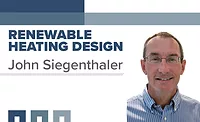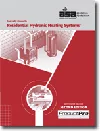Renewable Heating Design | John Siegenthaler
Versatile hydronic systems leverage time-of-use energy rates
When the price is right...

Black_Kira iStock / Getty Images Plus
As government electrification target dates loom in the near future, and power transmission systems get pushed closer to their limits, utility companies continue implementing ways to manage peak demand.
One load management technique used by some utilities is time-of-use (TOU) rates. The concept is simple: Utilities want to reduce the peaks in their daily electrical demand, and shift that energy consumption to times where demand is lower. They encourage customers to do this by offering significantly lower prices per kilowatt•hr of energy during low demand periods, while at the same time discouraging electrical use during peak demand times by pricing each kilowatt•hour considerably higher.
TOU rates can be as simple as a fixed rate during a defined “off-peak” period, such as 11:30 p.m. to 7 a.m., combined with a higher fixed rate during all other hours. These rates can also be more “tailored,” such as combining off-peak and on-peak rates with a “shoulder rate” that applies between on-peak and off-peak periods. Some TOU rates also offer off-peak rates 24/7 on weekends and major holidays based on anticipated lower demand. The times during which these rates apply can also vary with seasons. I encourage you to check out what your local utility has to offer — it’s likely posted on their website.
Figure 1 shows an example of a TOU rate structure with a shoulder rate.

Grab it!
Hydronic-based heat pump systems — especially those combined with low-temperature heat emitters — can take advantage of TOU rates. The concept is simple: Operate the heat pump during off-peak periods to meet the load and store any access heat in insulated tanks. The stored heat can then be used to maintain comfort during the subsequent on-peak period.
A system capable of capturing 24 hours’ worth of heat during the off-peak period is called a “full storage” system. A system that can capture some of the heat needed for a 24-hour period during the off-peak period is called a “partial storage” system.
Although you may be thinking that the full storage approach is always better because it only purchases energy when the price is lowest, this is not always true from the standpoint of return on investment (ROI). In some situations, partial storage systems will have a better ROI, mostly because they trade off substantially lower upfront costs against a “blend” of electrical energy prices. Which approach is best depends on the on-peak/off-peak rate differential, the difference in installation cost and the load characteristics.
For example, a building in a relatively sunny winter climate, built with substantial south-facing windows, may not need much, if any, heat input from 10 a.m. to 7 p.m. This would minimize the need to purchase electricity during the shoulder and on-peak periods. The use of nightly thermostat setbacks would reduce load, thus allowing more time for the heat pump to charge thermal storage rather than send heat directly to the building.
Water has the highest sensible heat storage ability of any practical material. Hydronic-based thermal storage systems have been around for decades and are used for both heating and cooling. Traditionally, thermal storage systems designed for heating have used resistance heating elements. In some systems, those elements are immersed in thermal storage tanks. In other systems, they are housed in electric boilers. Both approaches have advantages and disadvantages. Both are capable of heating water to 200° F. Even higher temperatures are possible, but safety concerns typically overrule operating these systems above the atmospheric boiler point of water.
Fast forward to today. Air-to-water heat pumps, as well as geothermal water-to-water heat pumps, are viable sources for charging thermal storage during off-peak times, and often competitive with other fuel options in terms of dollars per million Btu deliver ($/MMBtu) during shoulder and on-peak periods.
Modern air-to-water heat pumps operating on R-32 or R-454B refrigerant are capable of heating water to about 140° F, albeit at reduced COP as water temperatures increase toward upper limits.
Air-to-water heat pump systems with cascading refrigeration systems (e.g. where the condenser of an R-410a air-sourced refrigeration cycle supplies the evaporator of an R-134a refrigeration cycle with a water-cooled condenser) can generate leaving water temperatures as high as 180° F. When R-290 (propane) is eventually approved for use in the U.S., expect single-cycle air-to-water heat pumps capable of reaching 170° F and higher. CO2-based heat pumps can also reach these high temperatures.
Figure 2 shows one concept for a system that combines thermal storage with a monobloc air-to-water heat pump as its primary heat source.

Most manufacturers of monobloc air-to-water heat pumps require that they operate with an antifreeze solution. This prevents freezing during cold weather. It also protects the evaporator against freezing during cooling mode operation when outdoor temperatures are low.
One approach is to fill the entire system with antifreeze. However, that can get expensive for systems that require several hundreds of gallons of fluid. The other option is to use a heat exchanger to couple the heat pump to the remainder of the system, which operates with water.
The system in Figure 2 uses a generously-sized heat exchanger capable of transferring the full heating output of the heat pump without exceeding a 5° F approach temperature difference (e.g., the difference between the heated antifreeze solution entering the hot side of the heat exchanger and the warmed water leaving the other side).
The heat exchanger is piped for counterflow to maximize the average temperature difference between the two fluids.
The circuit between the heat pump and heat exchanger is a closed loop. As such it needs an expansion tank, pressure relief valve, circulator, and fill/purge valves. I also recommend installing an air separator, or a combination air and dirt separator.
The two storage tanks are connected in top-to-bottom series. This helps preserve beneficial temperature stratification. Although the system in Figure 2 shows two tanks, there could be more depending on the budget and operational goals of the system. In that case, the same top-to-bottom series piping would be used.
Flow logic
Circulator (P1) can deliver heated water from the heat exchanger to the hydraulic separator or the upper connection on the right side thermal storage tank. The water routing is determined by the status of motorized valves (MV1) and (MV2).
If (MV1) is closed and (MV2) is open, all flow from (P1) passes through thermal storage. This is the “charging” mode that occurs during off-peak rate periods.
If (MV1) is open and (MV2) is closed, all flow from (P1) passes into the hydraulic separator, and eventually through circulator (P3) to the load.
Which of these two modes is active at any given time depends on the status of the load, the current electric rate and the temperature of the thermal storage tanks. If necessary, the load is given priority over charging thermal storage to ensure that comfort is maintained.
When it’s time to move heat from thermal storage to the load, motorized valve (MV2) closes and valve (MV1) opens. Circulator (P2) is turned on, and its speed is adjusted by a 0-10 VDC signal to regulate the rate at which hot water from thermal storage is injected into the upper left inlet of the hydraulic separator. The injected hot water mixes with cooler water returning from the load inside the hydraulic separator to create a suitable supply water temperature to the load based on outdoor reset control. The supply temperature is measured by a sensor installed downstream of circulator (P3). Circulator (P1) is off, and a check valve in circulator (P1) prevents flow reversal through the heat exchanger.
One or both thermal storage tanks could be configured with electric resistance heating elements that could provide backup heat if the heat pump is down for service, or supplemental heat generation is needed during very cold outdoor temperatures.
Options
The system in Figure 1 is configured as heating-only. However, the same piping topology could be expanded to include cooling. The heat pump would cool thermal storage during off-peak periods. The chilled water would then be routed to the coil of an air handler as shown in Figure 3.

I suggest using two 3-way manually operated ball valves to isolate the heat emitters from the air handler when the latter is only used for cooling. They would be operated once in spring to reconfigure the system from heating to cooling, and once in the fall to convert back to heating. Two, 3-way motorized valves could also be used if the occupants don’t want to do these seasonal changeover adjustments.
Remember that it’s imperative to insulate and vapor seal all piping and components that hold or transfer chilled water.
This system configuration is not suited for locations where the climate necessitates frequent shifts between heating and cooling. In such cases, it’s necessary to set up separate thermal storage tanks for heated water and chilled water.
Flow splitting
Another possibility is to substitute a 3-way motorized proportional valve for (MV1), as shown in Figure 4.

This configuration allows the possibility of controlling the flow proportions that simultaneously go to storage and the hydraulic separator.
Consider a situation during the off-peak period when a relatively small zone load becomes active, but requires far less heat input than what the heat pump can deliver. In that case, the 3-way proportional valve could direct a small flow of heated water from circulator (P1) into the hydraulic separator. That flow rate would be based on maintaining the required supply temperature to the load. Any flow that didn't go to the hydraulic separator would pass through thermal storage. As the temperature of the water coming from the heat exchanger increases, the proportional valve automatically reduces the amount of flow to the hydraulic separator, and thus maintains the supply water temperature at or very close to the target temperature based on outdoor reset.
Challenge met
Once again, the versatility of modern hydronics allows for systems that leverage current and future energy market trends. Systems that cooperate with demand-side management programs offered by utilities without compromising comfort. It’s a win/win scenario. Are you ready to deploy it when the opportunity comes along?
Looking for a reprint of this article?
From high-res PDFs to custom plaques, order your copy today!








